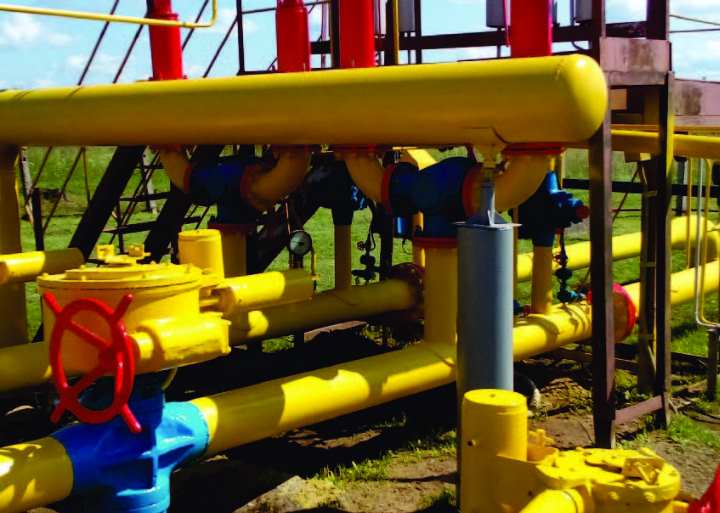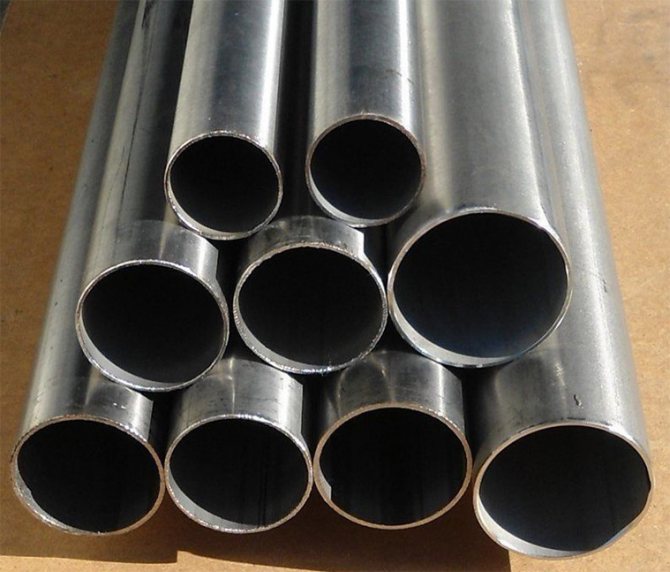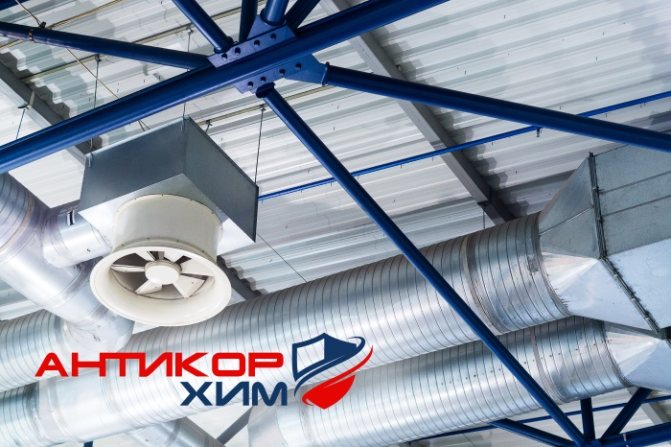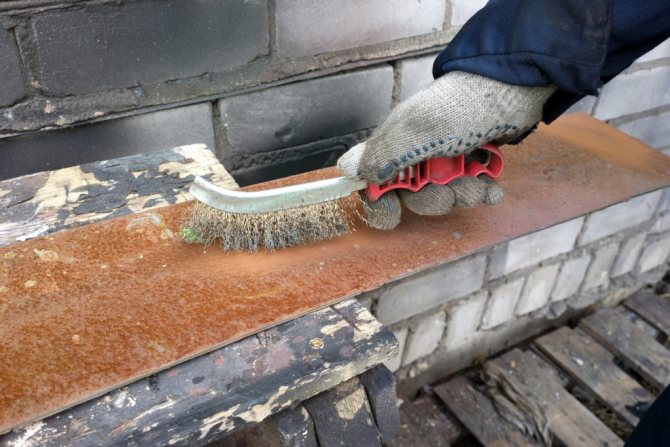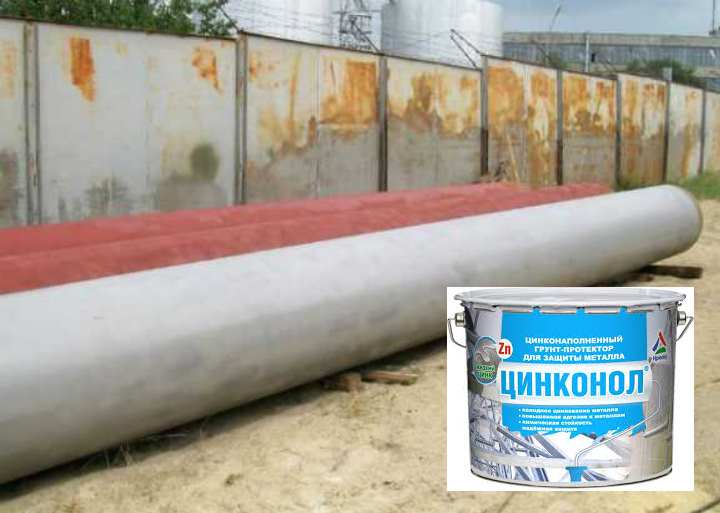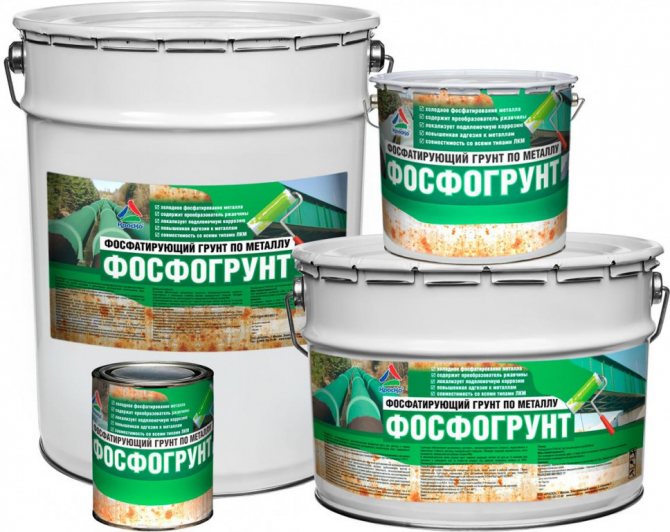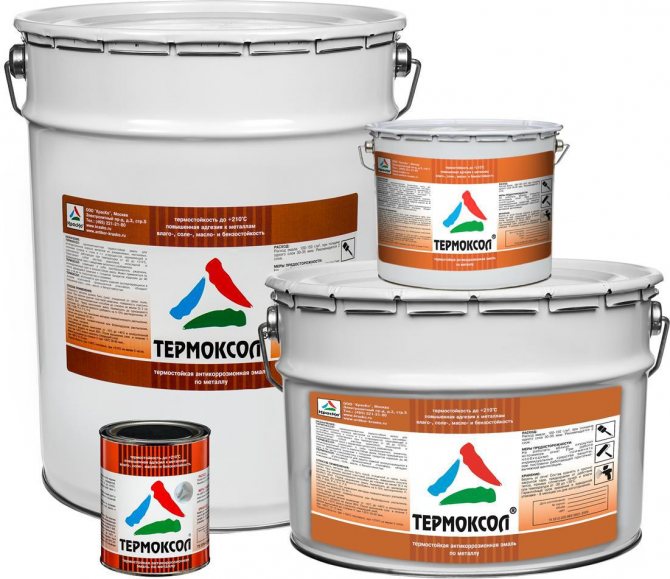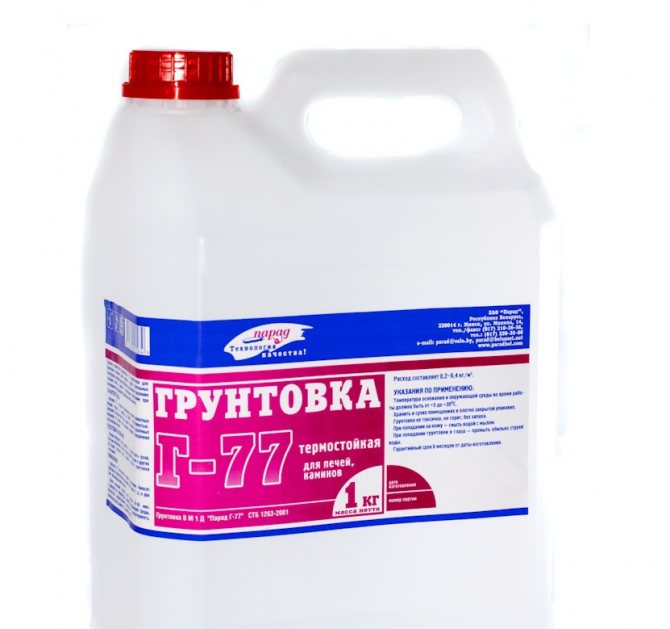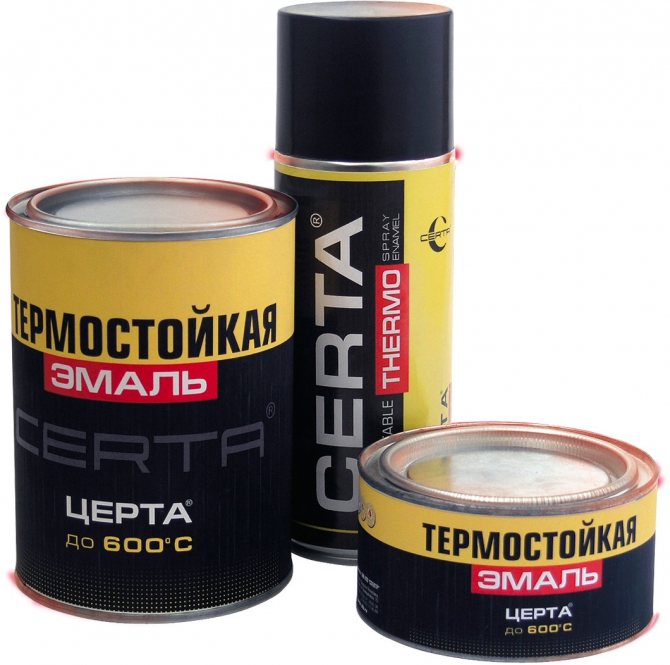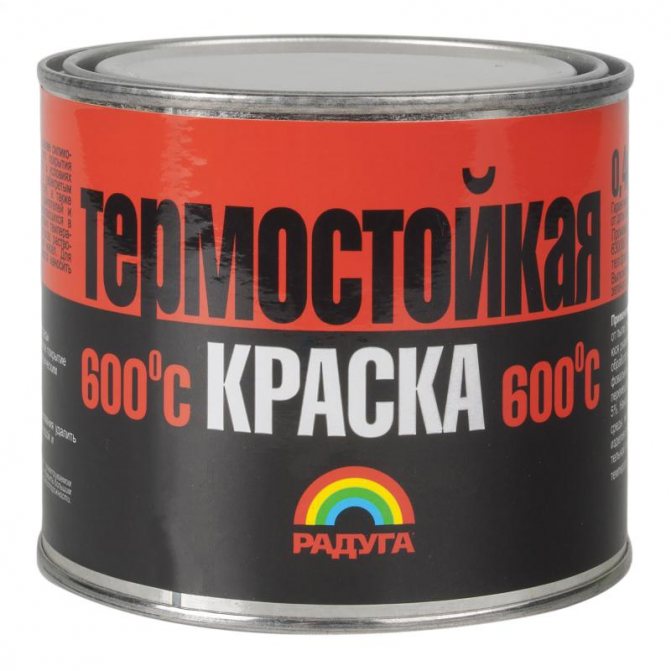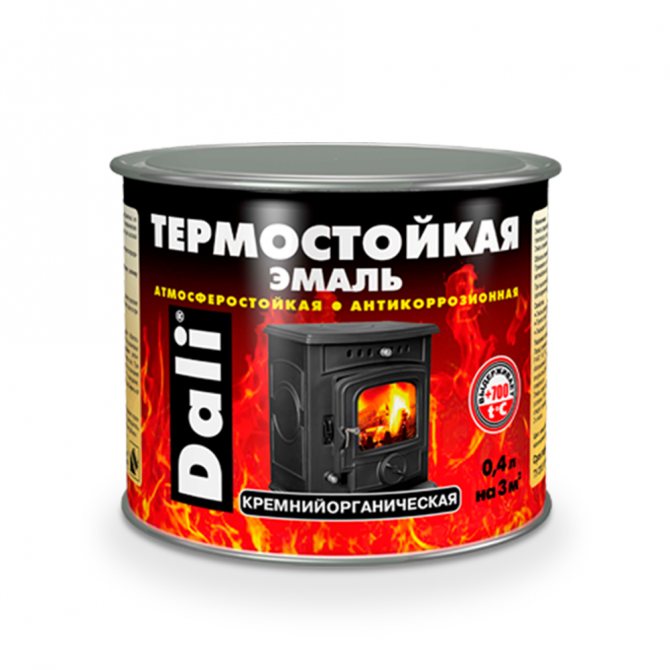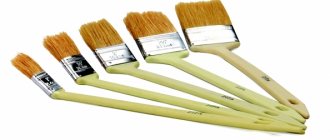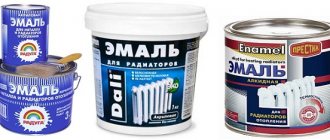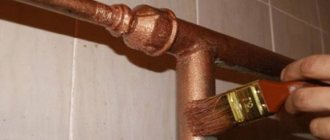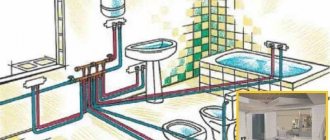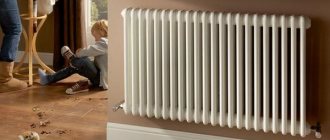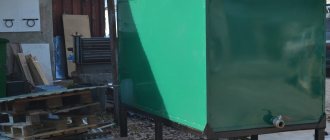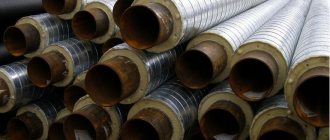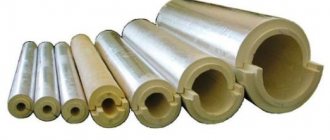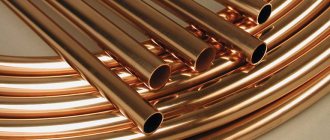Primer gf-021 gray and red-brown for metal and primer for pipes
If you have any questions about the goods presented on our website www.Komplektacya.ru, please contact the contact e-mail:, by multichannel phone or using the online consultant located in the lower right corner of the page.
GF-021 primer looksas a liquid-plastic mass with a specific smell of solvents used in the production process, adjusting additives and a desiccant used to accelerate drying. The composition is a suspension of glyphthalic or alkyd varnishes and anti-corrosion pigments with additives.
Primer GF-021 is widely used in outdoor works for preliminary protective coating of wood, metal or other products with which it has good adhesion, allowing for a long-lasting resistant pre-paint anticorrosive treatment. Before priming, especially if it is done with a spray gun, it is required to dilute GF-021 to reduce the viscosity level. In this case, xylene GOST 9949 or 9410, solvent GOST 10214 or 1928, or any of them together with white spirit (nefras C4 155/200) GOST 3134 in the recommended ratio of 1: 1, but the proportion of solvents should not exceed a quarter of the mass of the primer itself. It is possible to use turpentine; when painting in an electrostatic field, thinner RE-4V or its analogue RE-3V should be used. The surfaces to be treated are pre-completely cleaned of dirt, dust and old paintwork, traces of possible corrosion are removed, thoroughly degreased and dried. The applied coating retains its declared characteristics in the temperature range from forty-five degrees of frost to sixty degrees of Celsius, does not react with sea or fresh water, does not lend itself to the influence of mineral oils and detergents.
Application of GF-021 soil It is produced by roller, brush, spraying or vacuumization, immersion or other method at an ambient temperature of at least five degrees and not more than twenty degrees Celsius, preferably in two layers. The time required for the first layer to dry at a temperature of + 20 ° C is an astronomical day. The same conditions must be observed before working with the primer if it was at subzero temperatures during storage or transportation.
It is used as a base for paints and varnishes such as PF, GF, EF, FL and the like, but it can also be used as an independent coating. Produced mainly according to GOST 25129-82 red-brownish color, or according to TU light gray tones.
Primed structures differ smooth matte finish, or have a dull gloss, excellent sanding without "greasing" abrasive materials. Excellent strength and quality characteristics are primarily due to the use of high-quality high-molecular copolymers in the manufacturing process, and the relatively low cost of GF-021 is due to their domestic origin.
The primer should not be in the area of direct sunlight, the container must be hermetically closed, limiting the ingress of air and atmospheric precipitation. When working with it, you should use personal protective equipment that prevents the composition from getting into the eyes and on open areas of the body.It is recommended that painting work be carried out either outdoors or in a well-ventilated area, away from possible sources of ignition. It must be remembered that the GF-021 soil is toxic and requires specialized disposal; the discharge of residues into the general sewer system is categorically excluded.
CONSUMABLES AND RELATED PRODUCTS:
Paint brushes
flat and flange
Overalls and
household inventory
Moscow and other regions of Russia can find out the cost of delivery by contacting any nearest terminal of a transport company working with St. Petersburg. We, for our part, will ensure prompt delivery of cargo to any carrier you choose.
There is a discount system for bulk orders. Regular customers are always a priority for us, but for new ones we are always open to dialogue and mutually beneficial cooperation. Our product catalog includes the most complete list of offered goods, and for the objectivity of your choice, only original photographs are posted on all pages of the site. The price list, which reflects prices in real time, will help you to choose and buy the products you are interested in at the most favorable prices. Any of your comments, complaints and suggestions will not be ignored, we are waiting for them on our email. address
What paints are suitable for galvanized metal?
The zinc-protected surface has less adhesion to conventional paints than black steel. Therefore, for its painting, not ordinary, but special paints are required. They should be more elastic and have better adhesion.
To the anti-corrosion coatings already mentioned above, used for protected metal, it is necessary to add silver, a paint that, like stainless steel, is used for structures operated in normal and sea water.
The solution "FAS-104" is diluted with water in a ratio of 1: 100, and then the agent is applied and rubbed with a rag.
- Cycrol. It is used for coating galvanized sheet iron, but in all respects this acrylic paint on an organic solvent is also suitable for zinc-protected pipes. On sale there is a cyclone of white, gray, brown, burgundy, green colors. The advantage of painting with Cycrol is that there is no need to prime the surface before coating, but it is enough to apply one layer. By purchasing this paint, you must strictly follow the instructions for its use and storage. You should work with it in a respirator. The room must be well ventilated during and after work. It is necessary to store the paint in a tightly closed container, away from sunlight and hot heating elements and no more than 6 months. Especially it must be kept away from fire.
- Nerjalux. Acrylic high-adhesive enamel for coating non-ferrous metals and galvanized iron. The base color is white with a matte shade. Other colors can be obtained by individual order, but you will have to order not 5-10 kg, but much more. Working and storage conditions are the same as for Cycrol. Storage time in original packaging is 6 months.
- Silver. This paint is based on aluminum powder. This enamel is used to cover both ferrous and galvanized metal. It contains a mixture of organic solvents and corrosion-resistant additives. Working and storage conditions are the same as for Cycrol. Shelf life in original packaging is 1 year.
DESIGN PRESTIGE LLC
Avoc specialists dialogue> priming and painting of pipes hvs and gws
It turns out you can paint, you can not - a question of aesthetics?
(What welds should be primed / painted is in the normative)
SNIP 3.05.01-85
"Welding of galvanized steel pipes should be carried out with self-shielded wire of the Sv-15GSTYUTSA grade with Ce in accordance with GOST 2246-70 with a diameter of 0.8-1.2 mm or electrodes with a diameter of no more than 3 mm with a rutile or calcium fluoride coating, if the use of other welding materials is not agreed in accordance with the established procedure.
The connection of galvanized steel pipes, parts and assemblies by welding during installation and at the procurement enterprise should be carried out provided that local suction of toxic emissions or cleaning of the zinc coating for a length of 20-30 mm from the abutting ends of the pipes is ensured, followed by coating the outer surface of the weld and the heat-affected zone with paint, containing 94% zinc dust (by weight) and 6% synthetic binders (polystyrene, chlorinated rubber, epoxy resin).
When it is necessary to paint galvanized pipes
One of the reasons for staining galvanized pipes is that under the influence of the sun, air, water, a thin zinc film loses its quality over time: it becomes thinner, point damage appears. Then the protection becomes unreliable, and the steel quickly rusts.
In addition, the aggressive environment can damage zinc itself over time: a white coating forms on it. In such cases, painting extends the service life of the rolled metal.
Another reason why additional anti-corrosion protection is required is zinc flaking at welded joints.
It is recommended to paint water and gas pipes (VGP) when they are hot-dip galvanized, i.e., the protection is applied from the outside and from the inside.
Note! If galvanizing is present only on the outside, then there is no point in painting, because this is unlikely to extend the service life, since the inner surface of the pipe is still subject to corrosion.
There is no consensus on the need to paint galvanized pipes in an apartment. The decision is made by the landlord himself. If the metal structure violates the harmony in the design of the room, or the owner does not like the dull gray color of the pipes, he can paint them in any color.
Anti-corrosion insulation of steel pipes
1. Primer Primer Primer Primer Primer 2. Bituminous enamel Bituminous enamel Bituminous enamel Bituminous enamel Bituminous enamel 3. The same The same The same The same 4. - Kraft paper Hydroizol Hydroizol Hydroisol 5. - - Bituminous enamel Bituminous enamel Bituminous enamel 6. - - The same The same The same 7. - - - Kraft paper Hydroizol 8. - - - - Bituminous enamel 9. - - - - The same Total insulation thickness, mm 3.5 4 8 8.5 10.5
Insulation works are an important part of the overall complex of laying a steel pipeline, since the service life of pipes depends on the quality of the insulating coating and its resistance to destruction. The quality of the insulation depends on the quality of the insulating materials and the implementation of technological discipline during their installation.
Damage to the insulation and exposure of metal leads to the development of concentrated foci of corrosion and to premature through rusting, which can occur after 5-6 years of pipeline operation and even earlier. Damage to the finished insulation can occur during the transportation of the pipe and when lowering it into the trench.
Insulation work consists of the following main processes: pipe surface cleaning, surface priming and insulation patching.
Rust removal is best done with steel wire brushes (by hand or machine), sandblasting, or chemical cleaning. In the process, rust is swept away with a brush or broom, and the pipe surface is wiped with a dry cloth. The pipe is cleaned to a metallic sheen. Manual cleaning is difficult and time consuming. It can be facilitated by using an electrified tool in the chuck of which the shaft of a metal brush is inserted. The cleaned pipe should be primed on the same day. If the pipe is left overnight without a primer, then the cleaning before priming must be repeated.Cleaning of pipes in wet rainy weather is not allowed. If moisture gets on the cleaned surface, then after drying, cleaning must be repeated.
The primer can be prepared by dissolving one part of heated bitumen in three parts of gasoline. For the preparation of the primer, the same bitumen should be used as for the bitumen coating. Usually, dewatered grade IV bitumen (without filler) is used for this purpose.
To prepare the primer, the required amount of bitumen is chopped into pieces weighing 1-2 kg and loaded into a boiler, where it is heated to a liquid state (usually at a temperature of 160-180 ″ C). Then the bitumen is poured into the tank and allowed to cool to a temperature of 80-70 ° C. Gasoline is prepared at a distance of at least 50 m from the boiler in a special tank. Bitumen is poured into gasoline in a thin stream through a watering can, continuously stirring with a wooden stirrer until the bitumen is completely dissolved.
The prepared primer should be stored in a closed container. The primer is applied to the pipe surface in an even layer 0.1-0.2 mm thick with a bristle brush or roller without drips, clots and gaps. If rusty spots show through the primer, these spots are cleaned and primed again. Drying of the primer is checked by lightly pressing on its surface with the palm of your hand. The dried primer should not leave any marks on your hand.
Bituminous insulating coating (bituminous enamel) is prepared from grade IV bitumen (75-80% of the mixture weight) and a filler - kaolin (20-25% of the mixture weight). Instead of bitumen IV, bitumen of grades III and V can be used in a 1: 1 ratio with the addition of kaolin. Instead of kaolin, asbestos No. 7 can be used as a filler in an amount of 5% by weight of the mixture. To prepare the enamel, bitumen is loaded into the boiler in an amount of 75% of the required mass, and after heating to a temperature of 160-180 ° and dehydration, the rest of the bitumen is added.
After warming up the entire mass, a filler is poured into the molten bitumen in small portions with continuous stirring of the mixture. In the industrial line construction method, an insulating coating is applied to the pipeline using an insulating machine. The application of the insulating layer by hand can be done using a tarpaulin cloth and a watering can with a spout in the form of a narrow slit (Fig. 1).
Fig. 1. Manual application of an insulating coating:
1 - tarpaulin cloth;
2 - watering can:
3 - pipe
Wrapping the pipeline with waterproofing is performed immediately after the application of the insulating coating until it hardens. This will ensure good adhesion of the winding to the coating.
Hydroisol in the form of a tape 50 cm wide is wound around the pipe in a spiral with overlapping seams by 1-2 cm. The wrapper should fit tightly onto the pipe without wrinkles, folds and bags.
Waterproofing sheets should not have holes, tears, folds, bumps, etc. The ends of the rolls must be flat. Hydroisol should be stored in a dry room, protected from rain and sun, on a plank floor or deck.
The gaps of the insulating coating in the places of the seams that are welded in the trenches must be pre-cleaned, covered with a primer and an insulating layer with an overlap of the insulated part of the pipe.
Control over the quality of work
Control over the quality of work is carried out after each stage (welding, insulation, installation, etc.). If this is not done, then after each operation on the installation of the pipeline, the result of the previous work will become unavailable for verification.
For example, the imposition of the first layer of a seam no longer makes it possible to establish whether the joint was assembled correctly, whether the required gap was set, etc. And the application of bituminous insulation makes it impossible to check the quality of cleaning the pipe surface and the quality of the primer.
Therefore, in the construction of steel pipelines, quality control must be carried out continuously and in stages during operation. All materials used in welding and installation work must have certificates confirming their compliance with the requirements of GOST.
Checking the qualifications of welders is carried out by test welding of joints in conditions that are identical with the work ahead. During welding, welding modes are checked, the order of seam placement and slag cleaning between layers when welding multilayer seams.
When examining the joint, you should pay attention to the fact that the surface of the seam is even, slightly convex, without sagging, undercuts, pores and other surface defects. The joint presented for acceptance must be free of slag, splashes and dirt. Insulation quality control consists in checking the materials that are used in the process. Before applying the insulation, the quality of the pipe surface cleaning is checked by external inspection (absence of rust, dust deposits, moisture, etc.).
The application of the primer can be started only after the quality of surface cleaning has been certified. Acceptance of completed works on insulation is carried out by external examination of the insulation coating, checking the thickness of the insulation layer, the degree of adhesion to the pipe. The cover should not be squeezed out from under the edges of the wrapper.
After lowering the pipeline into the trench, it is necessary to check the correct laying of the whip and the safety of the insulation coating. Defective spots found during inspection should be immediately cleaned up and restored.
In internal water supply networks, steel pipelines of small diameter, until recently, had practically no competitors. The high cost of copper and stainless steel pipes made it possible to use them only in exceptional cases, where increased costs were justified.
The picture changed somewhat with the introduction of asbestos-cement and polymer pipes, which began to actively displace steel and cast-iron pipelines.
Recommendations for preparing for painting
The first stage of painting is preparatory work. Using sandpaper and solvents, the pipe is cleaned from rust, scale, oils, and old paint residues. Dirt and dust are washed off with detergents (you can use washing powder). This is to prevent the new enamel coating from peeling off. It is also important to get rid of the fat that builds up on the pipes in the kitchen.
We recommend that you familiarize yourself with: Metal pipe for laying an electrical cable
To remove fatty and oil deposits, use alkaline, acidic, alcoholic or water-based fat solvents, special emulsions (Chistomet-Ts, FAS-104, acetone half with toluene, etc.). Dry the surface after washing.
Note! After cleaning the surface with chemicals, it is washed with clean water, because the remnants of salts and other active compounds reduce the protective properties of the enamel coating, and corrosion centers are formed under it.
The second stage of preparation is priming. The primer itself already has a protective function. In addition, it provides reliable adhesion of the paint to the metal surface. It is not recommended to use alkyd compounds for priming, because they have a negative effect on zinc. Noteworthy are the following materials: Rostex Super, Grit Metal, Special Metal Primer.
Painting and protection of pipes and pipelines against corrosion, condensation and moisture
Name Standard AS-5305 enamel for marking on steel welded pipes during their manufacture TU 2313-028-21743165-2004 PF-5117 enamel for protection of lead-tin and aluminum pipes TU 6-10-1372-78 FL-613 enamel for surface protection of oilfield equipment, tanks and pipelines at chemical industry enterprises TU 6-27-163-2000 Enamel KhV-533 for coating the inner and outer surfaces of tanks and pipelines operating in the temperature range from -50 to +50 ° C TU 6- 10-1375-78 EP-5116 enamel for anticorrosion protection of pipelines, as well as for painting field oil pipelines and oil reservoirs of waterflooding systems GOST 25366-92 Enamel AK-1379 for painting various metal structures, oil pipelines, tanks, mechanical engineering and machine-tool products TU 6-27- 231-2001 Enamel KO-8104 for painting pipelines, heating devices, chimneys,railway tanks, tank equipment TU 6-00-04691277-42-96 Primer EP-0282 for corrosion protection of metal structures, equipment, various products made of steel, galvanized steel, aluminum and its alloys TU 6-27-18-295-2000 Primer EP-0287 for anti-corrosion protection of metal structures, painting of mineral carriers, and other surfaces made of carbon steels, stainless steel and aluminum TU 6-27-211-2001 EP-0280 GL primer for anti-corrosion protection of carbon steels, stainless steel, aluminum and its alloys, alloys copper and other non-ferrous metals TU 6-27-169-2000 Primer "Aqua-Tube" for interoperative corrosion protection of the outer surface of steel pipes and other metal surfaces TU 2316-038-27524984-2004 Primer "Gamma-Okhtek" for protecting the surface of steel pipes of field pipelines for transportation of oil and saline waste water TU 2312-041-27524984-2004 Inhibited composition XC-500 for corrosion protection of metal and reinforced concrete structures, pipelines in an industrial atmosphere of chemical production TU 6-10-2002-85 Universal enamel XC-1169 for the creation of chemically resistant paint coatings that protect various surfaces from aggressive environmental influences GOST 9355-81 Paint 85-1-93 to protect metal surfaces of equipment for hot water supply TU 2312-430-0-05034239-94 EP-5226 enamel for protection of pipelines, field oil pipelines and oil reservoirs of waterflooding systems TU 6-27-164-2000 Organosilicate composition KOS-12-03N (enamel KOS-1203 N ) for protection against atmospheric corrosion of metal structures, outer surfaces of chimneys, pipelines of water heating networks TU 2312-003-24358611-2006 EF-1242 enamel for painting pre-primed or unprimed rolled metal, thin-sheet steel TU 6-21-5011902-5- 90 FL-61 enamel for corrosion protection of surfaces of turbine mechanisms, pumps, tanks and cisterns washed by oil, as well as for metal TU 2312-131-05034239-99 Enamel FL-412 for corrosion protection of pipes of various ship pipelines, tanks, systems and containers exposed to hot water and steam TU 2312-131-05034239-99 Primer paint for metal "Ukhra 1503" for surfaces of pipes and tanks for drinking, technical, reclamation water supply, as well as for corrosion protection of metal structures for various purposes TU 2316-001-29346883-2001 Anticorrosive primer paint VD-AK-1503 ("Morning-1503") for anti-corrosion protection of various metal structures, tanks and water supply pipelines TU 2316-003-56869885-2005 OS-5103 enamel for corrosion protection of pipelines of water heating networks (with a coolant temperature of up to 180 ° C) and other purposes when laying underground in non-passage channels TU 6 -138-49235.074-89 Enamel KO-8111 for anti-corrosion painting of steam pipelines with superheated steam, product pipelines, oil pipelines, gas pipelines, chimneys and any other х metal structures exposed during operation to high temperatures up to 600 ° С TU 2312-001-59545798-2003 Enamel for radiators "Profi" for finishing painting of radiators, pipes for water heating and water supply in domestic and building conditions TU 2313-012-32998388 -2003 Composition "Kornika" (anticorrosive primer-enamel EP-1-100) for priming and self-protection of metal surfaces operated in an open atmosphere and high humidity, in gasoline, oil and oil products, salt and other solutions TU 2312-100 -00209711-2000 Primer "Gramirust" for priming metal structures, pipelines, cooling towers, enclosing structures, tank equipment and other objects exposed to the atmosphere containing corrosive gases and vapors, oils and various petroleum products TU 2312-088-00209711-2007 Basalt fiber insulation material BVTM for thermal insulation devices for building structures, pipelines, industrial equipment for household and household use, heating devices,ventilation systems TU 95.2691-98 Basalt fiber heat-insulating material BSTV for thermal insulation of industrial and household equipment, industrial pipelines TU 5761-001-08621635-98 Heat-insulating incombustible cylinders "EURO-SHELL" (Euro-Shell / F) for thermal insulation of pipelines of systems hot and cold water supply, heating systems, oil and gas pipelines, industrial pipelines for any purpose TU 5762-012-08621635-2010 KO-868 enamel for protective (anti-corrosion) painting of metal equipment operating in conditions of high humidity and high temperatures TU 2312-001- 49248846-2000 VG-33 primer for corrosion protection of oil and gas tanks, bridge structures, pipes and other metal structures TU 2312-004-29727639-97 EP-0259 primer for protection of hydraulic and port facilities, power plants, sea and river vessels fleet, steel tanks and pipelines of oil and oil products TU 2312 -174-00209711-2005 Enamel EP-5285 "Epofeniplen" for decontaminated finishing of structures of premises and external surfaces of equipment and pipelines at nuclear power facilities TU 95-2184-90
